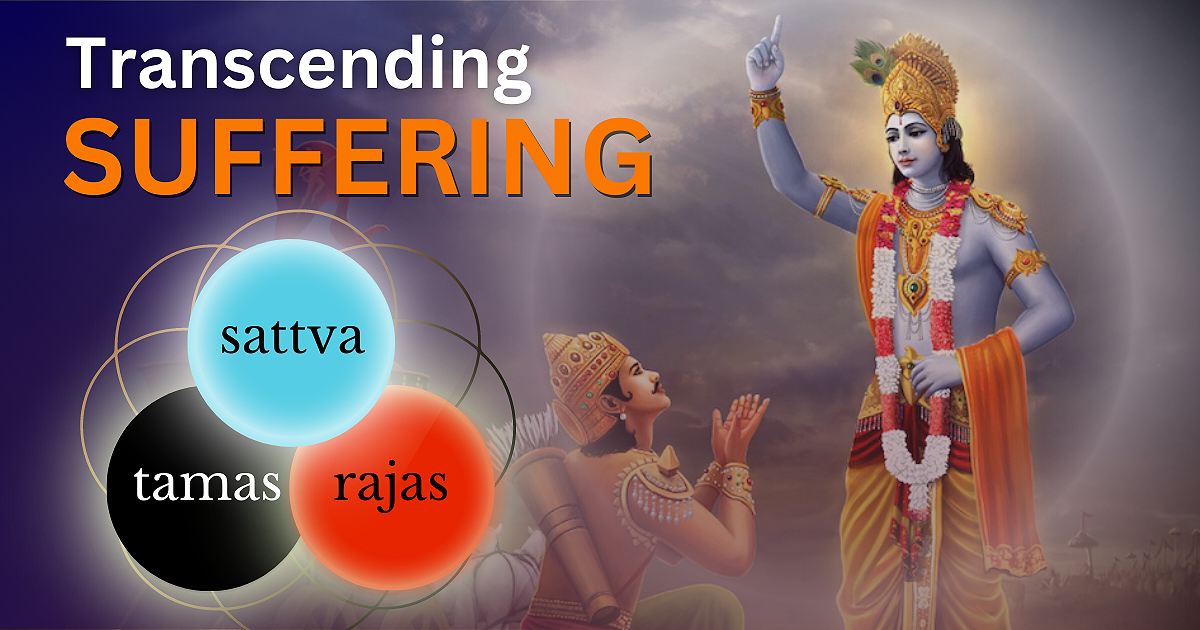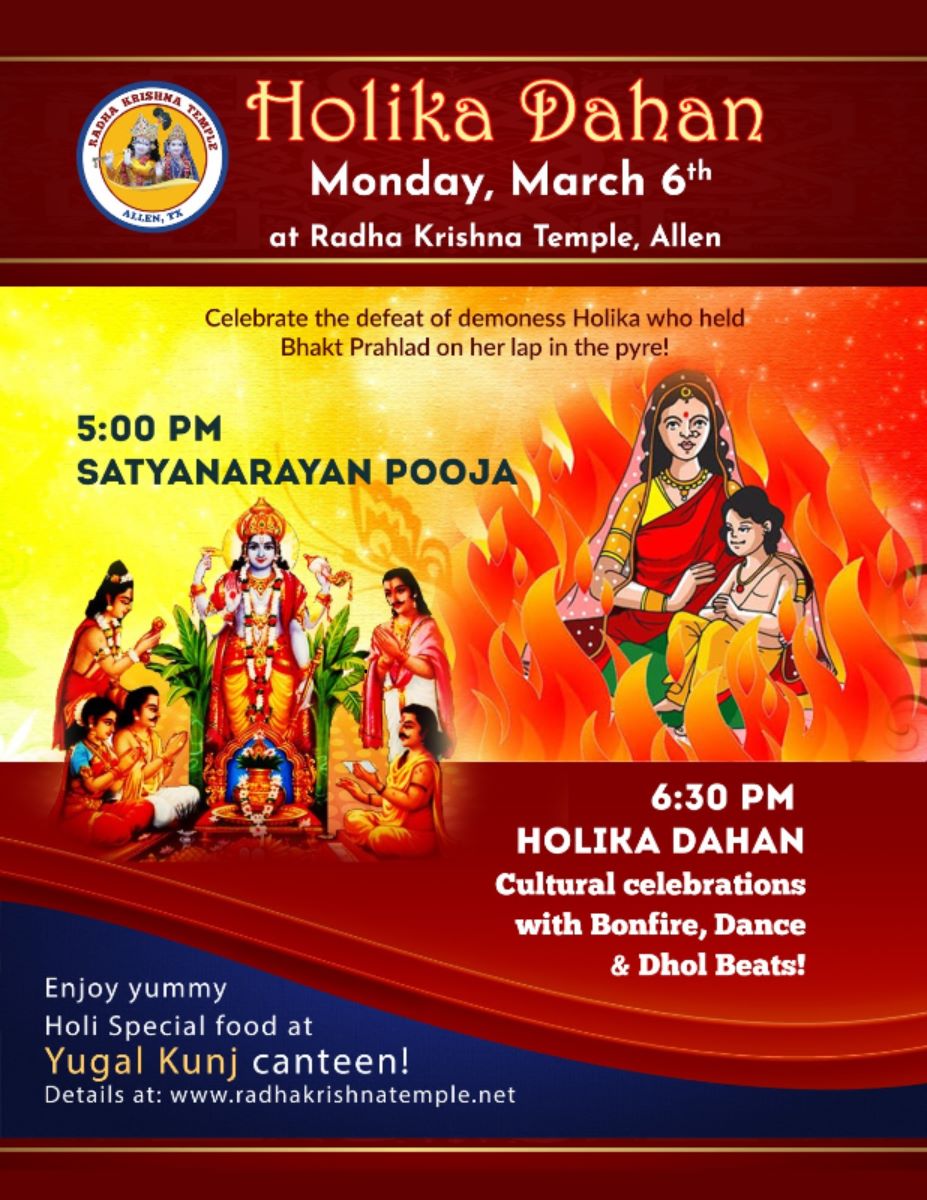Welcome to the February 2023 issue!

Welcome to the February 2023 issue!
 Quote
Quote
अहंममाभिमानोत्थै: कामलोभादिभिर्मलै: ।
वीतं यदा मन: शुद्धमदु:खमसुखं समम् ॥
ahaṁ mamābhimānotthaiḥ kāma-lobhādibhir malaiḥ
vītaṁ yadā manaḥ śuddham aduḥkham asukhaṁ samam
When one is completely cleansed of the impurities of desire and greed produced from the false identification of the body as ‘I’ and bodily possessions as ‘mine,’ one’s mind is purified. In that pure state, one transcends the stage of so-called material happiness and distress.
(Śhrimad Bhāgavatam 1.25.16)
 From the Editor's Desk
From the Editor's DeskNone of us wants to suffer, yet we do. We tend to believe that we suffer due to the external world. However, as Swami Mukundananda explains, “This entire world is a veritable form of God. It is perfectly designed in a manner to enrich us.” This comment is meant to prod us to perceive this aspect of God’s design as being beneficial for us. If so, what is the real reason for our suffering? Let’s dwell on this topic to transcend suffering.
All suffering reflects our internal state of mind. In the Bhakti Ras feature, we provide a basis for understanding this spiritual philosophy, ways to transcend suffering, and the role of Maya in our material lives. Additionally, we present a very elevated level of suffering that is evoked when souls experience the deep pain of separation from Shree Krishna in the Maharaas story featured in Bal-Mukund: Playground for Vedic Wisdom. Learn to practice Pranayam to alleviate suffering as described in the Holistic Health Titbits feature. Finally, keep yourself updated on Upcoming Events at the Radha Krishna Temple of Dallas (Allen) as a way to transcend suffering.
We invite our readers – adults and youngsters alike, to share their thoughts and perspective in the Discussion Forum in this issue. There are special Reflection Questions posted to encourage participation and engagement from the community.
 Bhakti Ras
Bhakti RasTranscending Suffering
External situations can only cause physical pain, not mental anguish. Physical pain is inevitable, but emotional suffering is optional. To set ourselves free from this suffering, we first need to be aware of its cause.
Why do we Suffer?
We suffer because we have not yet learned to master the mind and our senses of perception. As a result, we are swayed by Maya, the very powerful material energy of the Supreme Lord. Our Vedic scriptures inform us that our mind is made of Maya, which consists of three modes or guṇas – sattva (i.e., goodness), rajas (i.e., passion), and tamas (i.e., ignorance). Our body, mind, and intellect which are made from this material energy, also possess these three qualities. The blend of these modes in our being determines the nature of our disposition.

If sattva guṇa dominates, one is peaceful, contented, and generous. When the rajo guṇa gains prominence, it gives rise to endless desires and insatiable ambitions for worldly enhancement. Tamo guṇa causes laziness and delusion. For instance, a person walking on the sidewalk notices the most gorgeous flowers in his neighbor’s yard. Upon first glance, his heart fills with joy. We can assume that his mind is in the sāttvic mode. If he had desired to procure a similar shrub to beautify his own yard, his mind would be considered to be in the rājasic mode. But, if he had become upset because his neighbor’s yard was more inviting and beautiful than his own, the mind would be considered to be in the tāmasic mode.
All three modes bind us through attachment to furtive actions. Even the mode of goodness – which reduces our vices, alleviates material discomfort, and positions us on the path of virtue, binds us by creating attachment to a sense of happiness derived from true knowledge.
In essence, we suffer because the mind, deluded by Maya, has forgotten that we are the divine fragmental parts of the Supreme Lord. We are oblivious to the truth that we are spiritual beings having a human experience.
How do we Transcend Suffering?
As long as these three material guṇas are present, we will remain agitated and unsteady, resulting in sorrow and suffering. Guṇa also means rope, and these three strands of the rope bind us to the material world. We essentially have become prisoners of arishadvargas (i.e., the six internal enemies) – desire, greed, anger, envy, pride, and attachment – that reside in our minds. Therefore, it is vitally important to purify the mind.
To cleanse the mind, we must fix it on an object that is pure. Beyond this material realm is the divine realm of God – His names, forms, virtues, abodes, pastimes, and saints. If we fix our mind anywhere in this area, it will become pure, as Shree Krishna instructed Arjun:
मां च योऽव्यभिचारेण भक्तियोगेन सेवते |
स गुणान्समतीत्यैतान्ब्रह्मभूयाय कल्पते ||
māṁ cha yo ’vyabhichāreṇa bhakti-yogena sevate
sa guṇān samatītyaitān brahma-bhūyāya kalpate
Those who meditate upon me rise above the three modes of material nature and come to the level of Brahman.
The Supreme Lord is transcendental to the three modes of material nature. Only when we anchor our mind to Him, can we truly transcend suffering. Hence, while performing any action, we must remember that we are not the enjoyers of the results. The results are meant for the pleasure of God/Guru alone. As tiny parts of God, our inherent nature is to serve Him through all our actions. When we understand this principle, we will start detaching from worldly objects and strengthening the attachment with God and Guru through bhakti (i.e., devotion).
Does Maya Hinder or Help us to Transcend Suffering?
It does both, as it is a double-edged sword. Human life is a precious gift of God. He has given us one more opportunity to set ourselves free from Maya. Yet, it is the same Maya that continues to bind us. Actually, when Maya torments us, it spurs us towards God, accelerating our spiritual journey. This is why Kunti Devi requested Shree Krishna to bless her with a boon of adversities – so He would be there with the Pandavas as their only source of support. This incident took place when Shree Krishna was about to depart to Dwarka after the battle of Kurukshetra. At that time, Kunti Devi approached Him and offered her obeisance. Shree Krishna, very pleased with her devotion, told her to ask for a boon. She pleaded with the Lord:
विपद: सन्तु ता: शश्वत्तत्र तत्र जगद्गुरो ।
भवतो दर्शनं यत्स्यादपुनर्भवदर्शनम् ॥
vipadaḥ santu tāḥ śaśvat tatra jagad-guro
bhavato darśanaṁ yat syād apunar bhava-darśanam
I wish the calamities that happened earlier would happen again and again so that we could see You again and again. Seeing You means that we will no longer see repeated births and deaths.
(Śhrimad-Bhāgavatam 1.8.25)
Even though Kunti faced many trials and tribulations, she welcomed more difficulties because they provided an opportunity to contemplate on God and His glories. Thinking in this perspective repeatedly, would be considered to be deliberate practice (or abhyās) to fix the mind on God and train it to detach (i.e., vairāgya) from the material world.
Unavoidable problems and difficulties do come our way without invitation as do pleasant and amenable events. Thus, we must accept both of these as divine graces for our upliftment. To rise above these dualities, it is imperative to tolerate, build spiritual strength, and be firmly situated in God-consciousness. When we function from this platform consistently, external influences will cease to impact us, and the soul’s intellectual surrender will be complete. Then, with divine grace from God/Guru, we will be able to break away from the shackles of Maya.
 Bal-Mukund: Playground for Vedic Wisdom
Bal-Mukund: Playground for Vedic Wisdom
The Gopis Experience the Bliss of Maharaas with Shree Krishna
This story about the Maharaas Leela, describes what happens when devotees become proud of their connection with God. It also helps to understand how to overcome pride to bring God closer to the heart.
Approximately 5000 years ago when Shree Krishna descended on the earth, He engaged in many divine pastimes (or leelas) for the benefit of His devotees. One of those was the Maharaas Leela. The Gopis of Braj were very sincere devotees of Shree Krishna. They wished that Shree Krishna would be their husband so they could take better care of Him and serve Him. They worshipped Maa Katyayani (a form of Mother Durga) and asked Her to bless them so that Shree Krishna would be their husband. Seeing their pure devotion, love, and humility, on behalf of Maa Katyayani, Shree Krishna promised to fulfill their wishes by showering the highest form of bliss within one year.
A year later, on Sharad Poornima, the most attractive full moon night of the year, Shree Krishna started playing his flute. The sound of the flute, filled with love, immediately swept all over Braj. Upon hearing the sweet sound, selected Gopis, to whom Shree Krishna had made his promise, immediately dropped whatever they were doing and ran towards Him without worrying about their physical appearance.
Upon arrival, Shree Krishna put the Gopis through a test of devotion. Although they were taken aback by the questions He asked, the Gopis passed the test because their love was selfless. Finally, the Maharaas began. During the Maharaas, after a while and in a state of samadhi or trance, each Gopi felt as if Shree Krishna was dancing with her alone. Soon enough each Gopi developed pride thinking that Shree Krishna loved her alone because of her beauty and virtues. God is attracted by humility and repulsed by pride. To crush their pride, Shree Krishna immediately disappeared with Radha Rani, leaving the Gopis with the deep and intense pain of separation. The Gopis realized their mistake, repented for their pride, cried out for the Lord, and started searching for Shree Krishna everywhere in the forest.
Perceiving the pain of the Gopis, Shree Radha Rani empathized with her very close friends. She fabricated an act where she pretended to be very proud that Shree Krishna preferred Her company alone. As a result, the Lord disappeared from the scene. When the Gopis found Radha Rani sitting and lamenting n the forest, they all cried together and expressed their devotional sentiments by singing the Gopi Geet. Shree Krishna melted upon seeing their genuine regrets and manifested Himself before the Gopis.
In realization of their pride, they sang, what is known as the Gopi Geet, with total humility, beseeching the Lord to return to them. They sang His praises by recalling all the past incidents when He had saved the residents of Braj from a variety of ordeals and catastrophes. They were very confident that this time too, Shree Krishna would protect them from the pain of separation. Eventually, Shree Krishna returned and the Maharaas resumed, filling the hearts of the Gopis with divine bliss.
Practical Wisdom:
- Shree Krishna left the Gopis when they developed pride. Learn to think of your accomplishments and successes as a gift of God to avoid feeling proud. Everything you have is the grace of God.
- The Gopis realized their mistake and experienced the pain of separation. They sang the Gopi Geet to express their longing for God. Just like the Gopis, learn to attach your mind to God. Your mind will rise above all material bondages and become divine.
 Holistic Health Titbits
Holistic Health TitbitsImportance of Pranayam in Transcending Suffering
Amidst the overwhelming demands of everyday life, a regular practice of pranayam can help us to transcend the three gunas or modes of Maya. Simply becoming aware of the gift of the air we breathe can lead to better physical, mental, and spiritual health. Faced with the challenges of everyday life, we may not be aware that our breathing is shallow or irregular.
What is Pranayam?
Pranayam is a powerful tool to relax the body, mind, and spirit. Pranayam has been derived from two words “pran” meaning breath or pranic energy, and “ayam” meaning control. Pranayam is used to control or regulate the breath and the life force by oxygenating every cell in the body.
Our breathing and mind tend to match the flow of the three gunas: Sattvic (i.e., goodness), rajasic (i.e., passion), and tamasic (i.e., ignorance). The state of the mind directs the pranic flow and distribution based on the dominant guna, thereby impacting various functions in the entire body. Hence, the mind has a very subtle but strong connection with our pran. When we breathe in, along with oxygen, the body also absorbs vital pranic energy.
Due to stress and strain with work, family, or other responsibilities, the mind can become agitated and along with it the breath becomes fast-paced and remains shallow. If someone is grieving, the deep sorrow can result in an irregular breathing pattern. However, deep breathing can serve to reduce stress and grief, balance our energy, improve our mood, and allow us to maintain devotional feelings to enable us to transcend suffering.
Benefits of Pranayam
Twenty minutes of bending and stretching the body with asanas comprise good preparation for pranayam practice. Asana practice allows for the blood and oxygen to flow to various parts of the physical body and to prepare the body and mind for the subtler practice of pranayam. Yogic breathing is long slow, deep inhalation fully including oxygenation of the abdomen, the mid-body, and the upper chest. There are many different types of pranayam. With some simple instructions from a yoga teacher, you can begin a twenty-minute practice of pranayam.
For more details on how to practice Pranayam please join a Prem Yog class at either the Radha Krishna Temple of Dallas (Allen) or virtually.
For more information, in addition to the websites noted above, you may also refer to Swamiji’s published book, Yoga for the Body, Mind & Soul.
 Reflection Questions for Discussion
Reflection Questions for DiscussionWe invite our readers – adults and youngsters alike, to share their thoughts and perspective in the Discussion Forum in this issue. There are special Reflection Questions posted to encourage participation and engagement from the community.
Bhakti Ras
- In your opinion, why did God deliberately create Maya to bestow suffering on the souls?
- What would have happened if God had not created Maya and there would have been no suffering in this world?
Bal-Mukund: Playground for Wisdom
- Scriptures state that pride is a significant hurdle in the path of spirituality and must be given up. However, the Scriptures also do not condemn a devotee who takes pride in being a servant of God. If so, why did Shree Krishna leave the Gopis during the Maharaas when they had developed pride?
- How can we be humble on the path of spirituality?
Holistic Health Tidbits
- What are the different types of Pranayam, and how can they help in the physical and mental well-being?
- Are you aware that you can combine Pranayam with Roop Dhyan meditation for maximum benefit? Share how you practice Roop Dhyan during pranayam to help those who are learning this practice.
- What challenges did you experience in the process?
Please share your comments under “Join the Discussion” below.
 Upcoming Events
Upcoming EventsFestivals and celebrations provide an excellent opportunity to examine our inner selves and alleviate the suffering that is evoked by external events in the material world. Participate in these festivities to appreciate the underlying messages from our Vedic philosophy.
Upcoming Festivals
- Samuhik Satyanarayan Pooja followed by Holika Dahan (March 6, 2023, from 5:00 PM onward - see details below)
- Dhoom Machale Holi Concert (March 11, 2023, from 11:00 AM to 8:00 PM - see details below)
Save the Dates for Two Upcoming Festivals
- Ugadi, Gudi Padwa and Chaitra Navratri from March 22 to 30, 2023.
- Durgashtami and Ram Navami on March 29 and 30, 2023.
Both festivals will be celebrated at the Radha Krishna Temple of Dallas (Allen).
Stay tuned for details!
Holika Dahan

To experience a memorable and exciting Holi festival, the Radha Krishna Temple of Dallas (Allen) has organized a beautiful celebration for the community. Everyone has the opportunity to participate in the sacred depiction of Holika Dahan and have a fulfilling experience in this devotional celebration of the victory of virtue over evil. Devotees are invited to participate in the pooja that depicts the destruction of the demoness Holika who attempted to kill Prahlad, the earnest devotee of Lord Vishnu, by putting him in her lap on the burning pyre.
The eventful celebration begins with the auspicious Samuhik Satyanarayana Katha on Monday, March 6, 2023, starting at 5:00 PM, which will be followed by Holika Dahan. Both events will be held at the Radha Krishna Temple of Dallas (Allen).
Holi

JKYog’s Dhoom Machale Holi Concert
The Radha Krishna Temple of Dallas (Allen), JKYog’s official Headquarters, and Nanban have organized a wonderful Holi celebration filled with pure fun and excitement!
The Dhoom Machale Holi Concert will be held on Saturday, March 11, 2023, from 11:00 AM to 8:00 PM. Here are the exhilarating highlights:
- Bollywood Live Concert with Harry Anand & Aditi Singh Sharma
- Exquisite Braj Ras filled Phoolon Ki Holi with Radha-Krishna
- Special Holi Shringar, Darshan of Radha-Krishna and Jhanki
- Kids’ Play Zone All-day
- Food Mela All-day
- Meet & Greet plus Photo with Celebrities (Ticketed Event)
- Cultural Program
Location: Radha Krishna Temple, 1450 North Watters Road, Allen, TX 75013
Please check the Holi website to view ticket options and purchase tickets.
We look forward to seeing all of you at this wonderful program!
About Us
This magnificent Hindu temple is the serene abode of Shree Radha Krishna where you imbibe the nectar of love for God, celebrate festivals with the Indian community in Dallas, practice meditation and yoga, enrich your children’s lives with Vedic culture, or simply relax and enjoy the spiritual environment with your family.
Non Profit 501(c)(3)organization.
Federal tax ID:26-3490578.
Location
1450 N. Watters Road, Allen, TX 75013 (Dallas–Fort Worth Metroplex)
Phone: (469) 795-9130
Get Updates
Subscribe to our newsletter









